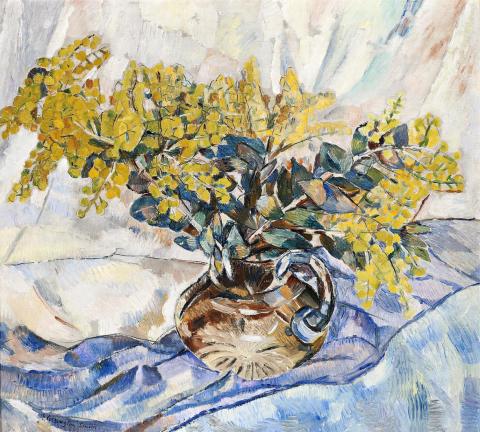WATTLE, c.1944
GRACE COSSINGTON SMITH
oil and pencil on board
40.5 x 44.5 cm
signed lower left: G. Cossington Smith
inscribed with title verso: "Wattle" / Mabel / with love / from grey / …
A gift from the artist to her sister, Mabel Packenham-Walsh, United Kingdom
Thence by descent
Private collection, United Kingdom
Christie’s, London, 16 December 2008, lot 20
Private collection, Perth
Drapery with Wattle, c.1944, oil on pulpboard, 45.0 x 40.0 cm, private collection, illus. in James, B., Grace Cossington Smith, Craftsman House, Sydney, 1990, pl. 82, p. 121
Wattle, c.1944 is a very special painting in Grace Cossington Smith’s oeuvre, confirmed by its gift to her elder sister Mabel. They were a very close-knit family. In 1912 Mabel (1891 – 1982) and Grace had made a two-year visit to England and the Continent. Mabel met her future husband, Ridley Pakenham-Walsh, on the ship returning the sisters to Sydney in 1914. Ridley, a young British officer, had been seconded to the training staff at Duntroon. War brought about an early marriage and their departure for England the following day. Grace later caught up with Mabel when she visited England again in 1948.1 The gift of a painting of wattle had added significance. Although golden wattle was not proclaimed the floral emblem of Australia until 1988, it had long been accepted as the popular choice. Its relevance would not have been lost on Mabel.
Cossington Smith’s patriotism was long standing, exemplified in such paintings as The Sock Knitter, 1915 (the artist’s sister Madge knitting socks for the Australian troops in the First World War) in the collection of the Art Gallery of New South Wales, Sydney and Dawn Landing, 1944 in the Cruthers Collection of Women’s Art, The University of Western Australia, Perth. Harbinger of spring and yellow, the artist’s favourite colour, wattle features in some of her finest flower paintings as Drapery with Wattle, c.1944 (private collection) and Drapery and Wattle, 1952 (Art Gallery of New South Wales, Sydney). During a recorded interview with Hazel de Berg in 1965, Cossington Smith said: ‘My chief interest, I think, has always been colour, but not flat crude colour, it must be colour within colour, it has to shine; light must be in it…‘. She continued ‘… Australian wildflowers are quite on their own, they are the most lovely things that we have and their colour is not what you’d call brilliant but it is a soft brilliant colour like our atmosphere, which is very wonderful’.2
Wattle is a characteristic painting of its time, the compositional high viewpoint centring on the vase, around which the flowers and drapery revolve. This ceaseless movement is shared with other still life paintings of the period, from Wildflowers, c.1940 (Art Gallery of New South Wales)3 through Wildflowers in a Glass, c.1943 (Deutscher and Hackett, 28 April 2010, lot 32) to Drapery with Wattle, c.1944 (private collection). An affinity between the latter painting and ours continues in the view of the containing jugs and sweep of flowers, the dynamic play of light in vibrant colour and separate, textured brushstrokes. Alive with colour and movement, Cossington Smith’s still life paintings are anything but still. Moreover, the transforming play of light recalls mosaics, the small pieces of coloured glass and stone set at angles to catch and reflect the light giving a shimmering radiance and luminous quality evoking the transcendental. So it is with Wattle, for Cossington Smith’s art is the expression of beauty and ‘… things unseen – the golden thread running through time’.4
Here, familiar objects of everyday life are transformed into things of wonder through the harmony established between outer presence and inner being. Within the characteristic flattening of pictorial space, everything revolves around the glass jug, continued in its very shape and reflections. Offering more than just radial movement, there is also the iconography of the drapery – sometimes anthropomorphic, other times ascending.
1. Modjeska, D., Stravinsky’s Lunch, Picador, Pan Macmillan Australia Pty Limited, Sydney, 1999, pp. 217 – 19
2. Cossington Smith, G., interview with de Berg, H., 16 August 1965, quoted in Thomas, D., Grace Cossington Smith, Art Gallery of New South Wales, Sydney, 1973, p. 6
3. Gifted to the Art Gallery of New South Wales in 1940 by twenty admirers of the artist’s work.
4. Cossington Smith, G., personal philosophy of art 1971, quoted in Thomas, D., op. cit., p. 6
DAVID THOMAS
